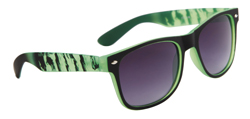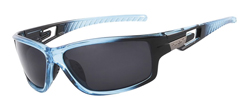 Ask three experts about trends in the Plano (or nonprescription) sunglasses market, and you’re likely to get three different answers. Why is that, considering that sunglasses are a nearly universal product and virtually every adult in American owns at least one pair? It turns out sunglasses are a little like T-shirts and social media: everyone has their own preferences, and when it comes to fashion, no two people are exactly the same. “Individualism is big right now,” said Ward Chen, manager of Got Shades International, a wholesale supplier of sunglasses. “People want to represent themselves.”
Ask three experts about trends in the Plano (or nonprescription) sunglasses market, and you’re likely to get three different answers. Why is that, considering that sunglasses are a nearly universal product and virtually every adult in American owns at least one pair? It turns out sunglasses are a little like T-shirts and social media: everyone has their own preferences, and when it comes to fashion, no two people are exactly the same. “Individualism is big right now,” said Ward Chen, manager of Got Shades International, a wholesale supplier of sunglasses. “People want to represent themselves.”
Making Trends Work
The Plano sunglass market is a huge and growing market, according to figures compiled by Grand View Research. Although the numbers vary a little bit, it is estimated that Americans buy about 285 million pairs of sunglasses every year, for a total market value of about $11 billion. The market has been growing between 3 percent and 5 percent annually for the last five or six years, and is expected to continue this rate of growth until at least 2018.
This roughly means that every single adult in the United States buys at least one pair a year—although kids and teens are also enthusiastic purchasers of sunglasses. “We have found that most people buy about 2-3 shades a year,” said David Chen, president of Pacific Link, a sunglass wholesaler.
With that kind of massive volume, manufacturers have filled the category with dozens of styles, and new ones are introduced all the time, from newer frosted glasses to innovative frame designs. The trick is to understand your local market—are your customers looking for fun in the sun or out hunting in the woods—and to have lots of variety. “Everyone has their own market,” Chen said. “It really depends on who you are selling to.”
 Kirk Bachelder, CEO of CTS Wholesale Sunglasses, sometimes works a retail booth for his company so he can stay close to his market, and he has found the same thing: variety sells. “In the retail environment, we will offer a few hundred styles of glasses,” he said. “You have to have a good mix of sports, fashion, polarized, and everything else. People tend to buy what they are used to buying, so you want to make sure you have it.”
Kirk Bachelder, CEO of CTS Wholesale Sunglasses, sometimes works a retail booth for his company so he can stay close to his market, and he has found the same thing: variety sells. “In the retail environment, we will offer a few hundred styles of glasses,” he said. “You have to have a good mix of sports, fashion, polarized, and everything else. People tend to buy what they are used to buying, so you want to make sure you have it.”
Even with a market this varied, there are still broad trends. Fortunately, it is not hard to figure them out. You only have to watch what celebrities are wearing. Since there is so much money on the line, the major sunglass manufacturers regularly sponsor celebrities to wear their new styles. Sometimes all it takes is one celebrity wearing a new frame to single-handedly touch off a craze. According to the experts, it is no mistake that heavy, black-framed wayfarer-type sunglasses are making a comeback. They are, after all, featured in the movies.
Color trends are also affected by Hollywood and the greater economy. The story in apparel and accessory retailing for the last few years has been neon colors, and those are still selling strong—alongside chunky black frames, mirrored aviator glasses, colorful and print wayfarer glasses, camouflage designs, and fashion frames modeled after famous designer looks.
“Celebrities drive sunglass style,” Bachelder said. “Then sometimes you will see something out of the norm come along, like a rapper will wear something unusual and it will take off, like the stunner glasses a few years ago.”
Merchandising for Success
The other major element dividing the sunglass market is price point. Although there is some minor disagreement on the exact price points, most experts agree that glasses under about $7.99 are considered low-end, while glasses over about $25 are considered higher end. This high end is where the trend-setting designer glasses live—but not the bulk of sales.
 According to Chen, about 80 percent of national sunglasses sales include glasses priced under $25, and most of those are in the $15 to $20 range. Below this price point, there is the perception that the glasses are cheap, and above that it starts to become prohibitively expensive for many consumers.
According to Chen, about 80 percent of national sunglasses sales include glasses priced under $25, and most of those are in the $15 to $20 range. Below this price point, there is the perception that the glasses are cheap, and above that it starts to become prohibitively expensive for many consumers.
“You should try to offer as many price points as possible,” Bachelder said. “If you can do a two-for offer, it will help, like do two for $25 or something. Also try giving away freebies like a microfiber bag.”
Because sunglasses are an impulse purchase, they do best when displays are located in high-traffic areas, like near the cash register, in a floor or counter display. “Everybody likes a cool pair of shades,” Chen said. “But unless they go to a specific store, like Sunglasses Hut, most people are not going out and looking for glasses. Instead, they will see a style they like and pick them up. Low price is not the only thing to consider. You have to offer sunglasses they want to buy.”
The best merchandise displays make it easy for consumers to handle the glasses and try them on—they include mirrors so people can see themselves in the glasses. This means it is also vital to keep the display clean, especially if your store is in an environment where people’s hands are dirty, like a beach or a boardwalk. Dirty fingers can leave smudges on the glasses, and no one will buy a pair of dirty glasses that look used. “You want people to try them on,” Chen said. “But keep the display clean and neat.”
Lastly, it is always a good idea to match the season. For retail customers, the sunglass-shopping season really begins right around Spring Break, when the weather begins to improve and people start heading outdoors. This means that savvy retailers are setting up their sunglasses displays around Valentine’s Day, to get ahead of the market and pick up any early sales.
The Online Market
The good news for brick-and-mortar retailers is that, because sunglasses are an impulse buy, there is not as much price pressure from online retailers. This is especially true at the lower and middle portions of the market, where the vast majority of sales occur. At the higher end of the market, people are more likely to go online and find their preferred brand and style and aggressively price shop.
“Online is hurting brick and mortar by cutting out delivery fees, overstocking, and lot of fees,” said Chen. “But this is a very competitive business. The online sales channel is just a new sales channel.”